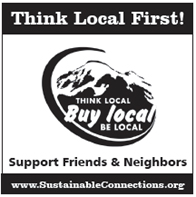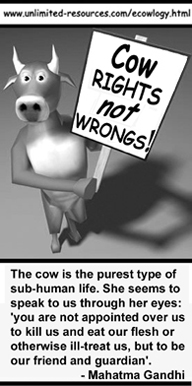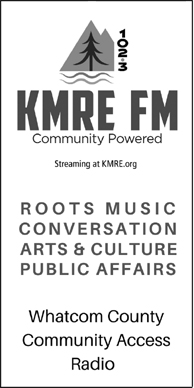by Michael Feerer
The news is filled with governmental decisions, particularly at a federal level,that will negatively impact Washington’s environment. It can feel both distressing and depressing. But I’m delighted to tell you about a very recent decision that will positively affect nearly all communities, forests, and habitats in Whatcom County and throughout much of Washington — for decades to come.

photo: Lexie Bright
Residents jumping for joy over removed ivy.
First, I’ll cut to the chase and reveal the decision. Then I’ll back up and explain why it’s important, how we got there, and what else can be done to continue the momentum.
It Happened in Olympia
It Happened in Olympia The Washington State Department of Agriculture (WSDA) (1), after an almost two-year administrative process that culminated in July 2025, added English ivy (Hedera helix) and Atlantic/Boston ivy (Hedera hibernica) to their Prohibited Plants and Seeds list (2). (I’ll refer herein to these two ivies as “English ivy” for simplicity.)
This WSDA list has clout. It determines which harmful plants are prohibited from being sold, transported, or distributed in Washington state.
Effective August 9, 2025, all nurseries, box stores, wholesalers, and other plant merchants within our wonderful state will no longer be able to stock or sell these highly damaging ivies. These two ivies are prematurely killing thousands of trees within Whatcom County and tens (possibly hundreds) of thousands of trees statewide.
Washington will become the second state in the nation to enact such a ban. Oregon was the first, in 2010. Although a sales ban alone will not eliminate the immense ivy problem, it will play an important role in gradually diminishing this destructive nonnative plant.
As a result, urban trees as well as rural forests will live longer and stronger to continue to capture carbon, support habitat and biodiversity, reduce urban heat, buffer floods, help our mental and physical well-being, and give their many other benefits.
It also will help to restore diverse native understory where ivy has aggressively taken over and dominated native plants that would otherwise be found on the ground. This will benefit a wide array of birds, mammals, pollinators, other bugs, and soil health.
It’s a huge win for everyone, one that (thankfully) does not suffer from political polarization. Most everyone seems to agree that English ivy is destructive and stopping its sale is an easy no-brainer.
And hey, a Bellingham nonprofit largely made it happen.

photo: Michael Feerer
Example of dead snag caused by English ivy.
Backing up a Few Years
Whatcom Million Trees Project (WMTP), relatively new to the nonprofit scene in 2021, began to partner with the Bellingham Parks & Recreation Department (and eventually Whatcom County Parks) to remove tree-killing ivies in local parklands and trails. WMTP’s concept was to laser focus on English ivy to build community awareness of its impact to trees and to boost the broader invasive removal efforts of those agencies.
It wasn’t a new idea. Other groups and nonprofits in Washington, such as Green Seattle Partnership and Edmonds Ivy League, also partner with local public agencies to magnify their ivy removal efforts. (8)
WMTP’s focused ivy removal work parties quickly made significant progress. (Consider joining one (7) — it’s fun and immensely satisfying!)
By early 2022, WMTP work parties had cleared ivy from several hundred trees in parks and Greenways. “Cleared” meant the ivy is removed from shoulderheight down plus in a 6-foot circle around the base of each affected tree. Tree climbing is not required because higher ivy strands, successfully cut off from soil nutrients, naturally die and fall off in a few months.
It was understood from the get-go that an ongoing, wave-by-wave ivy removal process would be required. Permanent removal was unlikely in one pass because ivy is so tenacious and aggressive. The clearing work typically gave trees a few unburdened years before nearby ivy strands might begin to re-climb. WMTP’s policy is to monitor the sites, returning periodically as needed to keep the ivy off the trees and (when feasible) widen the ground-level removal.
(Note: From this point on, I’ll often refer in this article to WMTP as “we” since I founded and led WMTP.)

Branching Out
Concurrent with ivy work parties, we developed other facets of our local ivy reduction efforts.
To supplement our comprehensive survey of public lands to map where ivy was threatening trees within Bellingham, we began to systematically canvas neighborhoods to quantify the extent of ivy on private parcels. And, we reached wider to survey the public and private lands in smaller Whatcom cities such as Blaine and Lynden.
Nobody had previously inventoried the extent of English ivy in our county. Armed with field data, we realized the scale of the ivy problem was immense here. More than 4,000 trees were threatened on private and public lands in Bellingham and smaller cities, as well as thousands of square feet of understory. We conservatively estimate at least an equal amount also exists in the vast other areas of Whatcom County.
What We Discovered
We already knew English ivy didn’t tend to grow in the middle of Whatcom’s large forests. It generally prefers the edges of canopy areas. Mapping ivy distribution locally graphically showed us how extensively it proliferated within communities, as well as at more isolated rural home sites.
There was a reason for that locational mix. Much to our dismay, local nurseries (both wholesale and retail) still sold English ivy, presenting it as a useful ground cover for landscaping.
Ivy cannot be effectively contained where it’s planted. Due to the berries that ivy produces, which birds eat and then spread the seeds via their droppings, ivy planted on private lots migrates to nearby parks, greenways, trails, and other public lands. It was appalling to us that a harmful species like ivy continued to be sold in the nursery trade while we and others directed significant resources toward eradicating it from natural areas.
So, we reached out to local nurseries to see if they would voluntarily stop selling English ivy. In return, we’d promote their willingness in WMTP’s social media, newsletter, and during our ivy work parties. We had high hopes for this partnership-based “carrot” approach.
We had some success. A few nurseries readily agreed, such as the wonderful folks at Garden Spot Nursery in Bellingham. Several other nursery owners, though, preferred to continue to stock English ivy, especially if competitors such as box stores (i.e. Lowe’s, Home Depot) continued to stock it due to being supplied by large regional nursery wholesalers.
A Breakthrough
There are certain nonnative plants nurseries cannot sell. The Washington State Department of Agriculture (WSDA) determines which ones with its Prohibited Plants and Seeds list, which is updated semi-annually (2).
English ivy was not on that list, but did sit on the state’s Noxious Weeds List (3). Confusingly, that latter list does not restrict what nurseries can sell. Produced by the Washington State Noxious Weed Board, it mainly guides the work of county noxious weed staff. The board also publishes lots of handy resources for the public to learn more about those damaging plants.
English ivy’s “Class C” noxious weed label meant that a county could optionally enforce its “control.” With limited funding and staff, and with so many other noxious weeds to also focus on, the Noxious Weeds List had little impact on reducing English ivy in our state.
English ivy needed to be added to the Prohibited Plants and Seeds list — the list that had clout.

Sidenote: Are non-native (i.e. “invasive”) plants the same as noxious weeds? Not always. Some noxious weeds are native, such as Devil’s club in Washington. A noxious weed designation means the plant is unwanted due to it damaging agriculture, the environment, or human health.
The Advocacy Campaign
WMTP mission is local, focused on the trees and forests within Whatcom County. Stepping into state or federal advocacy is done by WMTP only if it will significantly benefit local trees and forests. As a relatively small nonprofit, though, we must be very selective in where we devote our time and energies to broader advocacy.
Some people with whom we shared the sale ban idea thought we’d have little chance of success in the current economic and political climate. We heard vague references to a failed attempt about 15 years ago to ban English ivy. But we refused to allow ourselves to become skeptics.
After much consideration, we decided to go for it. Any progress with removing ivy is usually temporary and unsung. A sales ban was a chance for a long-lasting gain in a never-ending battle, one that would provide long-term benefi ts to Whatcom County and all of Washington.
So, we went to work. To make the case for an ivy sales ban, over many months WMTP collected nearly 1,500 petition signatures (online and written), wrote dozens of emails to policymakers and potential advocates, gave ivy presentations in numerous venues, and encouraged other organizations to also petition WSDA for this change.
A talented local filmmaker, Lexie Bright, helped us to create a 12-minute playful but informative mini-documentary titled “Ivy Eyes: Growing a Movement to Save Trees in Whatcom County.” (6) This film further built awareness throughout the community about the ivy problem and its potential sales ban.
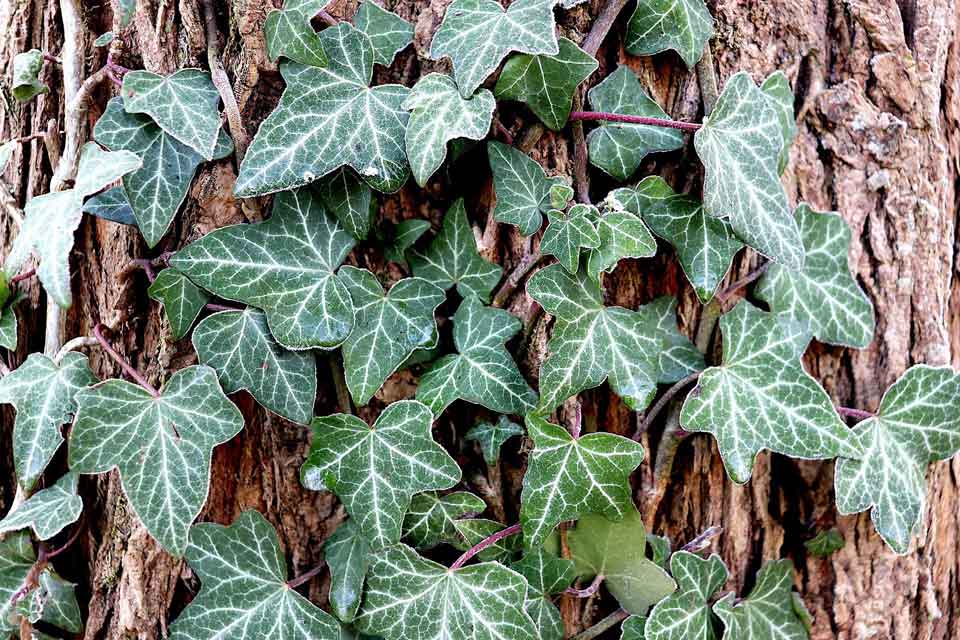
photo: Michael Feerer
Ivy closeup
A cool thing about our online petition software is it allows people to add brief comments in addition to their e-signature. Hundreds of signers did, which turned out to be a very powerful element for the WSDA to see. Below are a few examples:
- “This is a no-brainer. How can we allow the sale of a plant that kills off our amazing trees?” ~ B. A.
- “This is an easy one, do the right thing.” ~ C. M.
- “Please take this common-sense approach to address this problem.” ~ E. F.
- “I will keep pulling ivy till my hands wither from and seize up. It would be nice if you can help by not letting people plant more of this plant.” ~ J. R.
- “I’m a professional working in climate tech. We spend so much effort on decarbonization and carbon capture but not enough on the less sexy stuff – like saving the trees we already have.” ~ J. C.
- “A penny for prevention is worth a pound of cure!” ~ K. K.
- “It is frustrating to be pulling English Ivy off of native trees in our efforts to restore county greenspace, just to see it planted purposefully in a yard just across the street.” ~ M. H.
- “A small step that can have lasting positive results.” ~ L. P.
Another wonderful, unexpected thing occurred: WSDA staff told us they welcomed what had become the largest level of public participation they had ever experienced on a prohibited plants issue. That was so refreshing for us to hear! Th roughout the two-year process, WSDA staff were great to work with, promptly answered our questions, and were supportive of our petition submittals and research.
Documenting the Economic Impact
We helped WSDA staff to document any potential economic impacts of the sales ban, which would be a key factor in their decision. The economic losses from ivy are significant!
For nurseries, a statewide ivy sales ban would create no negative economic impact. Nursery staff we talked with confirmed that they simply could point customers to nondestructive ground covers they also off er for sale. In fact, since other ground covers tend to be not as aggressive as English ivy, perhaps a few additional starts would be sold per given area, giving the nursery a small amount of extra revenue.
For communities, there was deep economic impact. Parks and public works departments, numerous nonprofits, private-sector restoration firms, developers, small farmers/ranchers, landlords, homeowners, and other property owners all spend many thousands of dollars of time and energy dealing with the prolific spread of ivy.
These costs go beyond just ivy removal. There’s also the cost to remove and/or replace dead trees and to repair buildings ivy has damaged. There can be habitat restoration costs in critical lands. And there are sometimes insurance losses to cover when ivy-burdened trees fall on other property.
Finally, there are the enormous hidden costs of ecosystem benefits lost within urban forests, critical lands, and rural forest edges that are decayed by invasive ivy. That’s difficult to quantify but it’s a very substantial loss to all of us! As Bellingham’s draft Urban Forest Plan noted in 2022:
“Bellingham’s urban forest delivers approximately $6.3 million equivalent value of services per year for carbon sequestration, air pollutant removal, and runoff mitigation. It also provides a cumulative benefit of $42.4 million for carbon storage … These dollar values capture just a fraction of the benefits the urban forest provides to the community, many of which cannot be valued easily.”
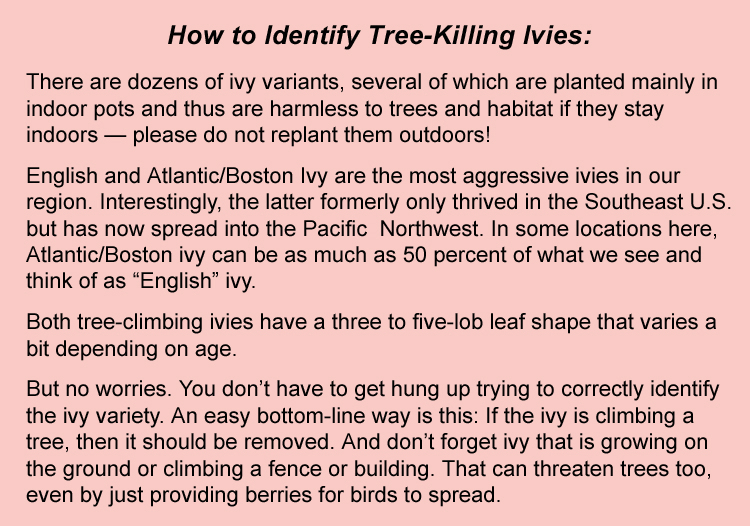
The WSDA Hearing
Almost two years passed as WSDA staff worked to ensure all potentially affected individuals, underserved groups, nurseries, and other stakeholders throughout the state knew about the potential ruling and had a chance to comment. Meanwhile, WMTP continued to send in more petition signatures and information, including feedback on the staff report that WSDA eventually produced.
Fortunately, their report recommended approval of a sales ban on English ivy and 17 other invasive plants. (See sidebar at the top of page 7.) This gave us cause for optimism, but we also knew anything could still happen in the final hearing.
After a long wait, a virtual hearing was scheduled on June 24, 2025. It was a final opportunity for the public to weigh in pro or con about any of the proposed additions to the Prohibited Plants and Seeds list.
We were on pins and needles.
The hearing seemed to go well. Nobody spoke against the ban. We recapped our two years of effort and submitted information, highlighting the economics as well as the environmental impact. Individuals from nonprofits and other groups in the state who we had encouraged to appear also testified favorably.
Several residents from Whatcom County spoke eloquently, too. One made the excellent point that a sales ban would help consumers who don’t otherwise know which plants are harmful when they go to a nursery. A lot of people want to do the right thing with plants but are uninformed.
After the hearing, one more rulemaking step remained: WSDA staff had to deliver their report, all testimony, petitions, and economic data to the WSDA director for a final decision. In the end, it all came down to one person.
We crossed our fingers and toes for two weeks. We had no idea if the farm-oriented 10-year WSDA Director would react favorably or not. There was very little information about him online.
Late in July, we heard the good news. Everything was approved! The sales ban would begin August 9, 2025! Hooray!
It’s Not a Panacea
Although we succeeded in securing a Washington state sales ban of English and Boston/Atlantic ivies, this alone won’t solve the ivy problem. There’s still all that existing ivy to remove, wave after wave, that continues to threaten trees and degrade our local forests. Over time, the sales ban will be an essential component to helping to reduce this very damaging invasive in our state. And hopefully, our success will inspire other states to adopt a similar sales ban. Time will tell.
It’s important to remain realistic about ivy progress. English ivy is so aggressive and entrenched. It’s unlikely we’ll collectively ever rid our region entirely of ivy. But, if we can at least keep it off as many trees as possible as well as out of vast chunks of understory in key watersheds and other sensitive areas for wildlife, then we will collectively have taken a really important step in restoring Washington’s green spaces as well as the health and climate resiliency of our communities.

What You Can Do Now
The ivy battle is far from over. Consider the actions below that you can take to help:
- Clear It From Your Home. Do you have English ivy in your yard? Consider replacing it with native plants. See our step-by-step ivy removal guide on our website. (4) (5) Using our proven method, ivy removal is relatively easy, doesn’t require special tools other than a hand clipper (plus maybe a small handsaw for any thick ivy roots), and no tree climbing is required.
If you have a lot of ivy on your property, consider a wave-by-wave approach like WMTP uses. No reason to try to remove it all in one afternoon. Spread out the work to make it more enjoyable!
Are you a homeowner who is physically unable to do the work yourself ? Consider hiring someone to remove it for you. With a little bit of Googling, you can find local firms who will do such work. Or hire a teen or college-aged neighbor to follow our removal process. Removal isn’t rocket science! - Hold an Ivy Party. Ivy removal can be a great excuse for a fun gathering of friends, family, and neighbors to work together on your property! Similarly, we’ve even supported environmentally conscious youth to gather friends for an ivy work party at a park as part of their birthday celebration!
- Rent? Ask your landlord. Offer to your landlord or property manager to not only remove the ivy but to plant native understory replacements if they will buy the plants. Explain how it will improve their property value and will help nearby parks, Greenways, trails, and other natural areas. You might be surprised at their response!
If ivy is already climbing trees there, be sure to mention your removal could save them thousands of dollars down the road (in insurance, hazard or fallen tree removal, etc.) by preemptively ensuring treetops will not snap off in a windstorm as the dense, heavy ivy burdens the canopy.
Note: Large condo complexes and apartments often already have hired landscape maintenance staff or contractors. Use our ivy information to encourage them to have their regular hired folks do the work. - Spread the word. The more people who understand the ivy problem, the less chance it will proliferate. We still run into lots of folks who have no clue that the “pretty green vine” climbing their tree or dominating part of their yard is destructive. Ivy awareness needs to continue to build.
Inform your friends, family, and neighbors about ivy’s harm to your neighborhood and our entire community. Point them to this article or our ivy webpage (4) if they want to learn more. Share our ivy social media posts on your favorite online platforms.
You a member of a homeowner’s association, neighborhood association, or local club? Such groups tend to be hungry for fresh presentations about topics of local significance. Suggest WMTP’s ivy presentation to be added to the mix. We’ll be happy to appear. - Join an ivy removal work party. It’s fun and immensely satisfying! No special skills or abilities are required. Spring through autumn every year, WMTP ivy removal work parties have engaged volunteers of nearly all ages in positive, hands-on, relatively easy action to enhance our community’s climate resiliency. (7)
Or sign up with other local organizations doing invasive removal work. Bellingham Parks & Recreation Department, Whatcom Land Trust, and Nooksack Salmon Enhancement Association periodically hold invasive removal work parties which can include English ivy removal.
With your own hands, while enjoying the company of like-minded others, in a few hours of relatively easy work you can save the life of several trees. Volunteers often come up to us at the end of such work parties to express how meaningful and rewarding the experience was for them. In an age of lots of depressing news, doing something tangibly positive for the environment with one’s own hands is a huge emotional joy and lift. How about you? - Donate to support tree-saving work. Okay, I can’t resist this plug. WMTP’s efforts to save local mature trees take considerable time and money — for staff, equipment, research, and more. We’ve made good progress in our first four years, having protected nearly 500,000 trees locally.
We track that metric accurately (and conservatively) on an internal spreadsheet which will soon be on our website. Our hands-on ivy removal is currently 2,000-plus trees of that total — and steadily growing. A much bigger amount is WMTP-facilitated acquisitions of forests (such as over 700 acres of prime Lake Whatcom watershed purchased by the City of Bellingham this past year) to be protected for perpetuity instead of logged. Note our metric doesn’t include trees that will be saved over time via the statewide ivy ban (since that’s not quantifiable), or trees outside of Whatcom County that our other advocacy efforts have also benefited, such as our work in improving wildland urban interface landscape buffer regulations.
If you can, consider sending a few dollars our way. As a small nonprofit, every dollar we receive make a meaningful difference to us in saving more trees. Our Donation webpage has many easy ways you can help, including no-cost methods such as adding WMTP to your Fred Meyer/Kroger Community Rewards shopping card.
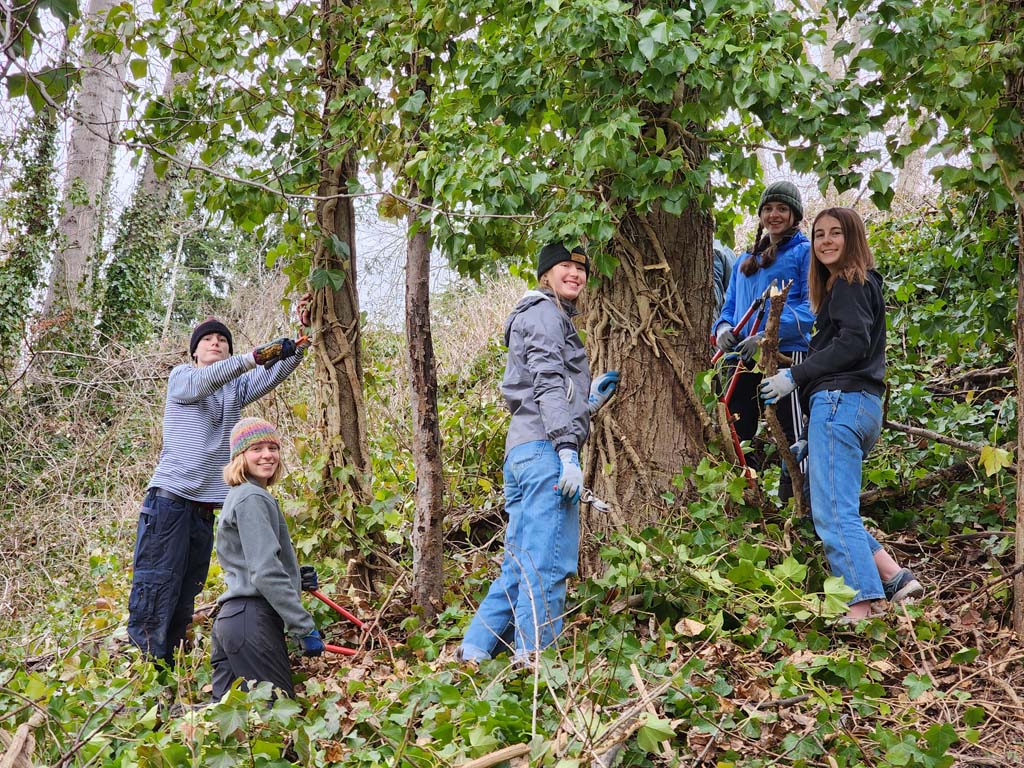
photo: Whatcom Million Trees Project
Whatcom Million Trees Project ivy work party volunteers
In Conclusion
The story of our English ivy sales ban success is now fully told. It’s a small but important step which demonstrates that significant, lasting environmental wins can occur in the face of increased societal challenges.
There’s no need to feel powerless. No need to wait for politicians to gain the resolve and funding needed to act for our environment. Individually and by working together, we can help our trees and forests to thrive and live longer, benefiting all forms of life in our region. We need that more than ever. Let’s keep the ivy removal momentum going!
__________________________________________
Michael Feerer founded Whatcom Million Trees Project in 2021. After leading WMTP as Executive Director for four years, he recently shifted to the WMTP Board and continues to work on special projects for the nonprofit. A voracious reader, granddad, and hiker, he’s walked in nature the equivalent of 1.6 times around Earth.
Article links
- Washington State Department of Agriculture (WSDA): https://cms.agr.wa.gov/
- WSDA Prohibited Plants and Seeds List: https://cms.agr.wa.gov/getmedia/9e83eb5b-8131-48a9-9066-aa76f077a219/brochureprohibitedplants.pdf
- WA State Noxious Weed List: https://www.nwcb.wa.gov/printable-noxious-weed-list
- WMTP’s English Ivy Removal Webpage: https://whatcommilliontrees.org/tree-projects/tree-protection/english-ivy-removal/
- WMTP’s Step-By-Step English Ivy Removal Guide: https://whatcommilliontrees.org/pubs/WMTP-English-Ivy-Removal-Steps.pdf
- WMTP Mini-Documentary — Ivy Eyes: Growing a Movement to Save Trees in Whatcom County: https://youtu.be
- Upcoming WMTP Ivy Work Parties: https://whatcommilliontrees.org/work-party-volunteering/
- Other Ivy Removal Volunteer Organizations in WA:
– Green Seattle Partnership: https://greenseattle.org/
– Edmonds Ivy League: https://www.instagram.com/edmondsivyleague/


